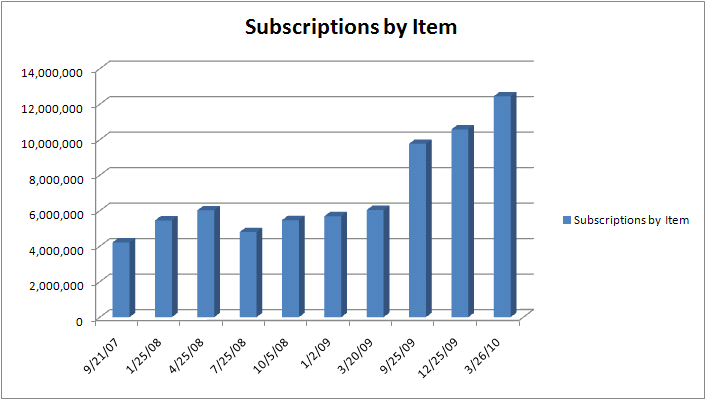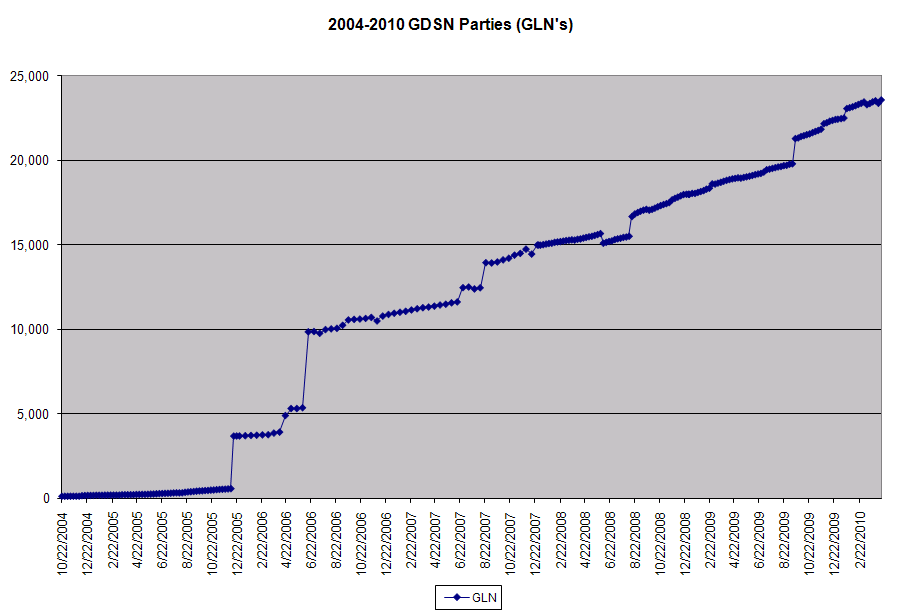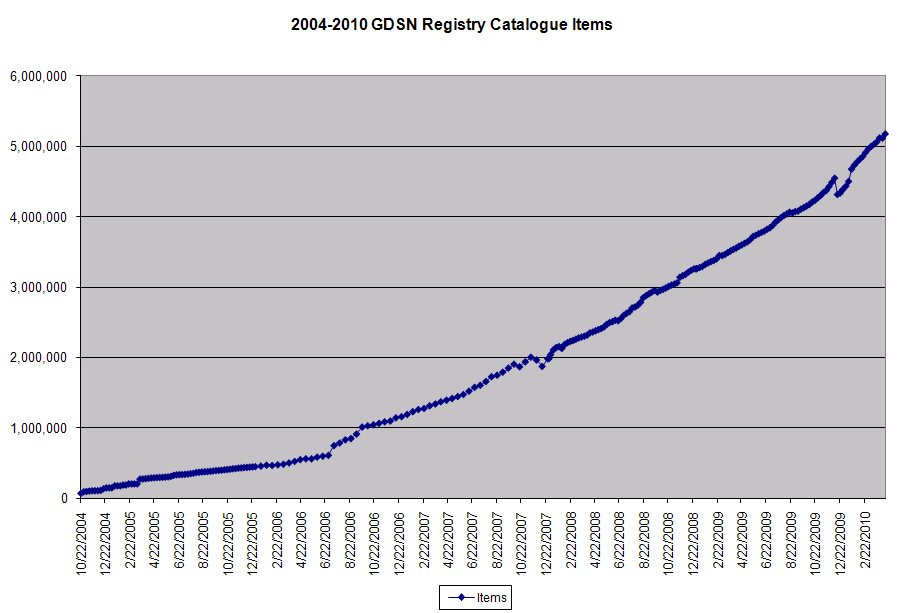The GS1 Item Alignment initiative via the GDSN now includes foodservice and healthcare and is rapidly advancing worldwide.
This article provides an update on the status of GS1 standards-based Item Alignment via the Global Data Synchronization Network (GDSN). A lot has changed in the last two years. GS1 US has a new CEO, Bob Carpenter, who is devoted to the advancement of GS1's core mission in the United States. I believe that having a senior executive who is fully committed to advancing the standards-based initiatives in the U.S. and improving commerce for GS1 community members is a good structural change. Further, it is my opinion that GS1 has found a quality individual—experienced, hard-working, and well-educated—to fill the organization's most important leadership role. I spent some time speaking with Bob Carpenter, as well as some of his key executives. What I learned is detailed below.
Executive Vision and Focus for GS1 US
Carpenter has set five key areas of focus for GS1 US that he calls "The Focus Five":
- Community Enablement: This includes better processes, tactics, and tools, including better analytics to bring companies "on board" with item alignment, EPCglobal adoption, and other GS1 initiatives.
- Sector Focus: New organizations have been formed within GS1 US to advance adoption in the foodservice and healthcare industries.
- Data Quality: The effort here is to develop specific tools and practices, including a data quality scorecard, to enhance and improve the accuracy of product information related to the Global Trade Identification Numbers (GTINs) being transacted in the network. GS1 US is actively working with retailers in this area. This focus helps bring about a smoother and more valuable adoption of the internal master data-management initiatives that are ongoing at so many companies.
- Fresh Food: This area involves not only bringing the standards-based initiatives of GS1 US efforts—found for so many years in "dry goods"—to meats and produce, but also providing meaningful initiatives to improve product safety and traceability.
- Breakthrough Projects: These initiatives are a bit more long-term. Bob Carpenter has assigned an experienced GS1 US product executive to look toward the future and bring two key, broadly defined areas of interest to fruition: 1) Visibility 2010: Use the power of RFID to show exactly where GTINs are in the supply chain for the Electronic Product Code (EPC) and the EPC Global Network. This has potentially huge value relative to product authenticity, supply-chain management, and product-recall consumer safety. 2) B2C: Ensure the authenticity and accuracy of product information available to consumers through electronic channels. This includes things like being able to scan products in a store with a mobile device (e.g., cell phone, BlackBerry, iPhone, etc.) with a bar code reader-scanner and quickly see things like extensive nutrition, product content, and potentially competitive pricing information.
Figure 1: Subscriptions by GTIN over 30 months (click images to enlarge)
The Numbers on GDSN Adoption of GS1 Item Alignment
Working for a leading vendor of GS1 Item Alignment solutions, I meet with many companies looking to improve their supply chain using GS1 standards. I sometimes hear comments like, "Oh, yeah, I remember that data sync thing. What happened to it?" This section proves that the GS1 Item Alignment adoption, as communicated over the GDSN over both 6- and 2.5-year time horizons, is thriving. The numbers and charts below are compiled from GS1 adoption reports.
Over nearly a six-year span, participating Global Location Numbers (GLNs) have increased from 137 to 23,574, and GDSN-registered GTINs have increased from 74,609 to 5,171,170. The following charts show growth trends. In the 30-month period of September 2007 to March 2010, the number of GLNs in the GDSN increased 67 percent, and the number of GTINs in the GDSN increased 173 percent.
Figure 2: GLN Growth over 5+ Years
Figure 3: GTIN Growth over Last 5+ Years
There are now 28 GDSN Certified Data Pools around the world. The following table shows the current activities of eight of the most active data pools in the GDSN.
|
GDSN Activity by Data Pool (April 16, 2010) |
|||||||||
|
|
Totals |
1SYNC |
SA2 Worldsync |
GS1 Colombia |
Big Hammer |
Commport |
GS1 Spain |
GS1 Australia |
GS1 Mexico |
|
Trading Partner GLNs |
23,574 |
8,086 |
2,105 |
4,983 |
889 |
152 |
313 |
1,748 |
2,504 |
|
Retailers |
345 |
201 |
36 |
4 |
7 |
4 |
12 |
24 |
0 |
|
Suppliers |
23,229 |
7,885 |
2,069 |
4,979 |
882 |
148 |
301 |
1,724 |
2,504 |
|
Registered Items (GTINs) |
5,171,170 |
3,851,980 |
350,308 |
162,978 |
243,005 |
38,866 |
72,819 |
219,551 |
152,735 |
To put some context around growth in the use of the GDSN as the method of communicating items aligned using GDSN standards, I spoke with Susie McIntosh-Hinson of the GDSN Inc. division of GS1. She provided this information:
GDSN began with about 200 companies and six data pools in 2004. The landscape today shows many positive trends unfolding. The growth in GDSN adoption is being driven from several areas, which are expected to continue to drive exponential growth:
- Country penetration and expansion is growing. GDSN is now active in over 90 countries, with the number anticipated to continue to increase due to new regions implementing GDSN, as well as early adopters of GDSN focusing on both regional expansion and internal implementation of data quality and business process automation initiatives.
- Data pools within the network have grown from 6 to 28.
- Sectors have spanned well beyond CPG to include healthcare, hardlines (product lines primarily consisting of merchandise such as hardware, housewares, automotive, electronics, sporting goods, health and beauty aids, or toys), chemical ingredients, foodservice, and support for mobile commerce trusted data.
- As multi-nationals expand to new regions, they can leverage the network to connect to their local/regional manufacturers or distributors.
Digging into the Details
With the big picture on GS1 US goals and initiatives defined, it was time to dig into the details. To learn what was going on, I spoke to the leaders of the key focus areas (i.e., The Focus Five) specified by GS1 US CEO Bob Carpenter.
Foodservice
Longtime GS1 US executive Dan Wilkinson is now in charge of helping the foodservice industry adopt GS1 standards. Wilkinson provided the following history, update, and insight relative to this initiative:
In October 2009, 55 founding member companies came together to support the voluntary adoption and implementation of GS1 global standards by individual foodservice companies that wanted to achieve complete and accurate data with their trading partners. Here's what they're looking for:
- GS1 Location Identification: Global Location Number (GLN) for unique brand-owner identification
- GS1 Product Identification: Global Trade Item Number (GTIN) for foodservice products to ensure unique identification of individual products
- Baseline product information (product attributes): Aligned product information throughout the supply chain from manufacturer to distributor to operator—to include nutritional, allergens, and ingredient information.
- Access to standard product information through the GS1 Global Data Synchronization Network (GDSN).
Industry organizations and founding members of the Foodservice GS1 US Standards Initiative cite three main objectives and industry-wide benefits as a result of companies choosing to adopt and implement GS1 standards:
- Drive waste out of the foodservice supply chain
- Improve product information for customers
- Establish a foundation for improving food safety and traceability
Within the foodservice industry, GS1 standards have been endorsed by industry associations such as the International Foodservice Distributors Association (IFDA), the International Foodservice Manufacturers Association (IFMA), and the National Restaurant Association (NRA).
I was intrigued by the incredibly rapid advancement in the foodservice initiative, so I attended the NRA show in Chicago, May 24-25. GS1 held a special meeting for the foodservice initiative at the event, and it was quite an eye-opener. There were nearly 100 director and C-level executives on-site at the meetings, with 20-30 others joining by phone and online meetings. This was an incredible show of support in a very short period of time.
For more information about the foodservice initiative, distributors or operators can contact Lance Esposito at
Healthcare
The following information comes from conversations with GS1 Healthcare US President Dennis Harrison and materials compiled and written by Annette Pomponio, GS1 US Director of Marketing.
GS1 Healthcare US was formed in January 2008 to support U.S. healthcare industry goals to improve patient safety and increase supply-chain efficiency through the adoption and implementation of global GS1 standards. Since that time, membership has grown to 125 healthcare organizations representing all areas of the supply chain, including distributors, group purchasing organizations (GPOs), government agencies, healthcare providers, industry associations, manufacturers, pharmacies, and solution providers.
Members have established five active workgroups to address important industry supply-chain issues in these areas:
- Product Identification (GTIN)
- Location Identification (GLN)
- GDSN Implementation
- Traceability Adoption
- Application and Implementation
To accelerate wide-scale adoption and implementation, industry-accepted "sunrise" dates were established to standardize location and product identification throughout the U.S. healthcare supply chain. 2010 GLN Sunrise calls for the adoption of GS1 GLNs in lieu of custom account/location numbers to standardize healthcare location information by December 31, 2010. 2012 GTIN Sunrise calls for the adoption of GS1 GTINs in lieu of custom product numbers to standardize healthcare product identification by December 31, 2012. The 2012 GTIN Sunrise initiative also includes the use of the GS1 GDSN to store and communicate the associated product attributes of each GTIN.
The industry-wide initiative to adopt GS1 standards for location and product identification will help to ensure that the correct products are delivered to the correct locations at the correct time, creating a safer, more efficient, and less expensive supply chain. Expected benefits include improved order and invoice processing, accurate chargeback and rebate processing, and efficient traceability/recalls.
Within the healthcare industry, GS1 standards have been endorsed by many industry associations and key stakeholders, including the Association for Healthcare Resource & Materials Management (AHRMM), Amerinet, Becton, Dickinson and Company (BD), Cardinal Health, the Committee for Healthcare eStandards, Inc. (CHeS), the Health Industry Group Purchasing Association (HIGPA), MedAssets, Novation, Sisters of Mercy/Resource Optimization & Innovation (ROi), Premier Inc., Strategic Marketplace Initiative (SMI), University HealthSystem Consortium (UHC), and VHA, Inc.
Broad support for the GS1 standards initiative in healthcare has been expressed by leading industry participants. A collection of these letters and studies is detailed below.
- BD Reaffirms Commitment to GS1 Data Standards
- Cardinal Health Statement on Adoption of GS1 Standards
- VHA Inc. and 13 Large Health Systems Press FDA for GS1 Standards in UDI Regulations
- LANSA Data Sync Direct Integrated with Oracle Product Information Management
- Industry Survey Shows MMIS Vendors on Track with GS1 Standards
- Lawson Software, the Leading Healthcare MMIS Vendor, Selects LANSA to Extend Supply Chain Integration Capabilities of Lawson ERP Solutions to Support GS1 Item Alignment via the GDSN
- AHRMM Endorses GS1 Standards Sunrise Dates
- Novation Endorses GS1 Standards to Drive Supply Chain Efficiency
- Premier Healthcare Alliance Endorses Supply Chain Standards to Enhance Patient Safety, Reduce Costs
- The Strategic Advisory Committee (SAC) of Premier healthcare alliance, comprised of 25 of Premier's largest healthcare systems, issued a joint letter to over 800 suppliers endorsing GS1 supply chain standards to improve patient safety and reduce supply chain costs
- Resource Optimization & Innovation Adopts GS1 Healthcare Standards
- SMI Announces Support for GS1 US Industry Standards and Adoption Alignment with GS1 US
- Global GDSN Pilot
- GTIN Allocation Rules for Healthcare
Major Data Recipients GDSN Update
As 1SYNC is a leading GDSN data pool, readers can get a good overview of what is going on with key retailers at www.gs1us.org/customers. This site provides a list of key retailers receiving information via the GDSN. Keep in mind that some, not all, data recipients create landing pages that can be found here.
From this site, you can also view the letters that key retailers and distributors have sent their suppliers outlining their efforts in GS1 Item Alignment via the GDSN, including Walmart, Sears, Kroger, Lowe's, Bunzl, Wegmans, McLane, SuperValu, Premier, and Acosta.
Going Forward
With new GS1 US Senior Executive Bob Carpenter at the helm, we should expect to continue to see widespread expansion and adoption of the aforementioned initiatives. The objectives he has outlined for the organization (detailed at the beginning of this article) will benefit all GS1 members and the supply chain as a whole.
The GS1 Item Alignment initiative via the GDSN is advancing very well worldwide. The evidence is clear, with the number of GLNs in the GDSN increasing by 67 percent and the number of GTINs in the GDSN increasing by 173 percent over a 30-month period. New key industry participants, including foodservice and healthcare, are strong indicators as well.
























 More than ever, there is a demand for IT to deliver innovation. Your IBM i has been an essential part of your business operations for years. However, your organization may struggle to maintain the current system and implement new projects. The thousands of customers we've worked with and surveyed state that expectations regarding the digital footprint and vision of the company are not aligned with the current IT environment.
More than ever, there is a demand for IT to deliver innovation. Your IBM i has been an essential part of your business operations for years. However, your organization may struggle to maintain the current system and implement new projects. The thousands of customers we've worked with and surveyed state that expectations regarding the digital footprint and vision of the company are not aligned with the current IT environment. TRY the one package that solves all your document design and printing challenges on all your platforms. Produce bar code labels, electronic forms, ad hoc reports, and RFID tags – without programming! MarkMagic is the only document design and print solution that combines report writing, WYSIWYG label and forms design, and conditional printing in one integrated product. Make sure your data survives when catastrophe hits. Request your trial now! Request Now.
TRY the one package that solves all your document design and printing challenges on all your platforms. Produce bar code labels, electronic forms, ad hoc reports, and RFID tags – without programming! MarkMagic is the only document design and print solution that combines report writing, WYSIWYG label and forms design, and conditional printing in one integrated product. Make sure your data survives when catastrophe hits. Request your trial now! Request Now. Forms of ransomware has been around for over 30 years, and with more and more organizations suffering attacks each year, it continues to endure. What has made ransomware such a durable threat and what is the best way to combat it? In order to prevent ransomware, organizations must first understand how it works.
Forms of ransomware has been around for over 30 years, and with more and more organizations suffering attacks each year, it continues to endure. What has made ransomware such a durable threat and what is the best way to combat it? In order to prevent ransomware, organizations must first understand how it works. Disaster protection is vital to every business. Yet, it often consists of patched together procedures that are prone to error. From automatic backups to data encryption to media management, Robot automates the routine (yet often complex) tasks of iSeries backup and recovery, saving you time and money and making the process safer and more reliable. Automate your backups with the Robot Backup and Recovery Solution. Key features include:
Disaster protection is vital to every business. Yet, it often consists of patched together procedures that are prone to error. From automatic backups to data encryption to media management, Robot automates the routine (yet often complex) tasks of iSeries backup and recovery, saving you time and money and making the process safer and more reliable. Automate your backups with the Robot Backup and Recovery Solution. Key features include: Business users want new applications now. Market and regulatory pressures require faster application updates and delivery into production. Your IBM i developers may be approaching retirement, and you see no sure way to fill their positions with experienced developers. In addition, you may be caught between maintaining your existing applications and the uncertainty of moving to something new.
Business users want new applications now. Market and regulatory pressures require faster application updates and delivery into production. Your IBM i developers may be approaching retirement, and you see no sure way to fill their positions with experienced developers. In addition, you may be caught between maintaining your existing applications and the uncertainty of moving to something new. IT managers hoping to find new IBM i talent are discovering that the pool of experienced RPG programmers and operators or administrators with intimate knowledge of the operating system and the applications that run on it is small. This begs the question: How will you manage the platform that supports such a big part of your business? This guide offers strategies and software suggestions to help you plan IT staffing and resources and smooth the transition after your AS/400 talent retires. Read on to learn:
IT managers hoping to find new IBM i talent are discovering that the pool of experienced RPG programmers and operators or administrators with intimate knowledge of the operating system and the applications that run on it is small. This begs the question: How will you manage the platform that supports such a big part of your business? This guide offers strategies and software suggestions to help you plan IT staffing and resources and smooth the transition after your AS/400 talent retires. Read on to learn:
LATEST COMMENTS
MC Press Online